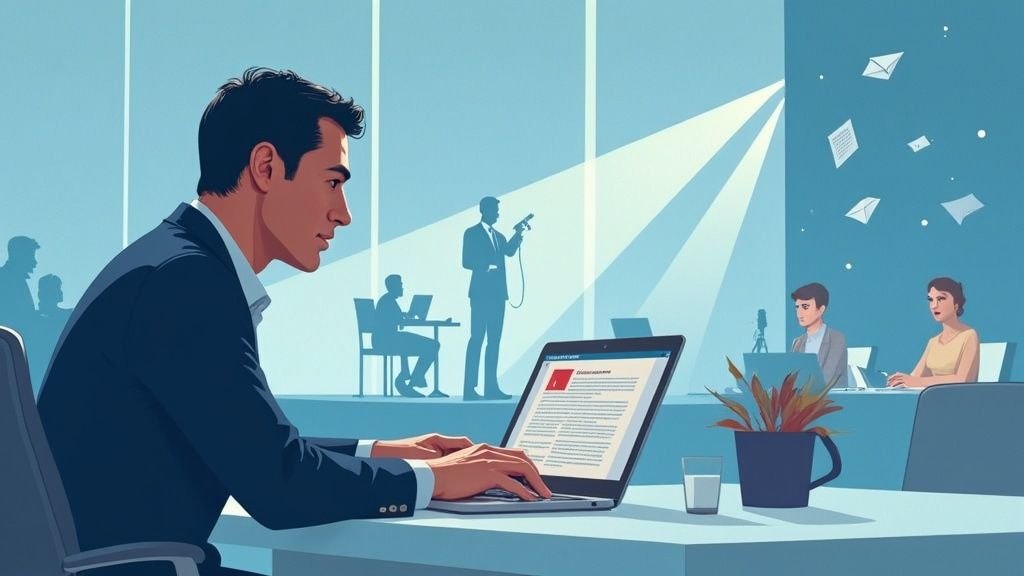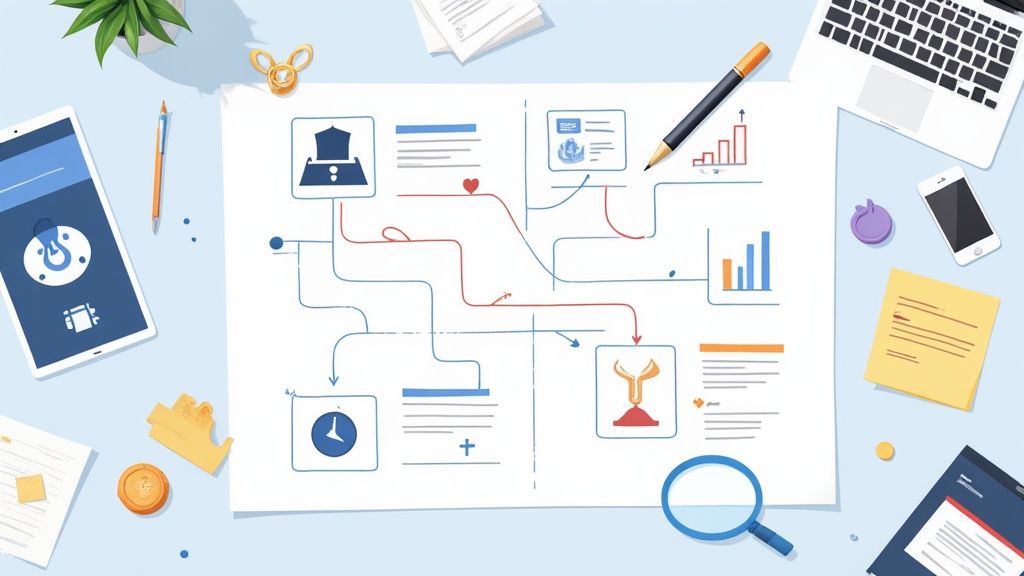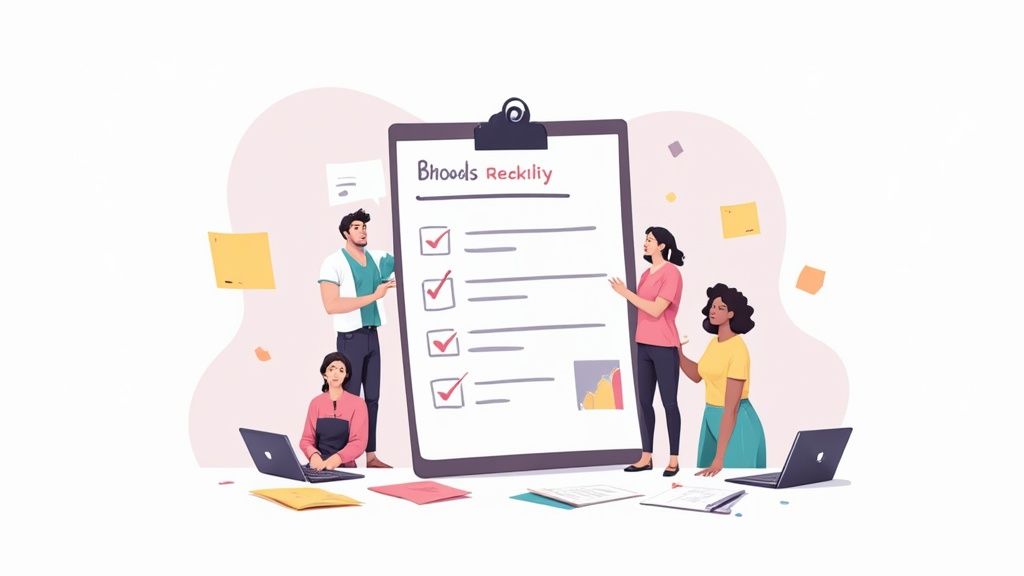A sharp, well-written press release for your event is an absolute powerhouse. It's more than just an announcement; it’s the tool that gets you media coverage and builds some serious credibility. Think of it as your event's official, verified introduction to the world, giving journalists everything they need to tell your story.
Why Press Releases Are Still a Game Changer for Events
In a world overflowing with social media campaigns and influencer shoutouts, you might be asking, "Do I really need a press release?" The answer from our perspective is a definite yes. While creating a buzz on social is great for engagement, a press release is the foundation of any professional event promotion strategy. It's the single source of truth that gives your event instant legitimacy.
A modern press release isn't just about announcing the who, what, when, and where. It’s a strategic asset. When done right, it can give your event's search engine optimization (SEO) a major boost, making it way easier for people to find you on Google. Every time a release gets published online, it creates a valuable backlink and tells search engines your event is something worth paying attention to.
Building Authority and Reaching New Audiences
Beyond the SEO perks, a press release establishes your brand as an authority in your field. Getting your event mentioned in reputable publications—even smaller, niche ones—provides a type of third-party validation that a sponsored post just can't buy. This is how you build real trust with your audience and potential partners.
This data really nails down the benefits of using a modern press release strategy.
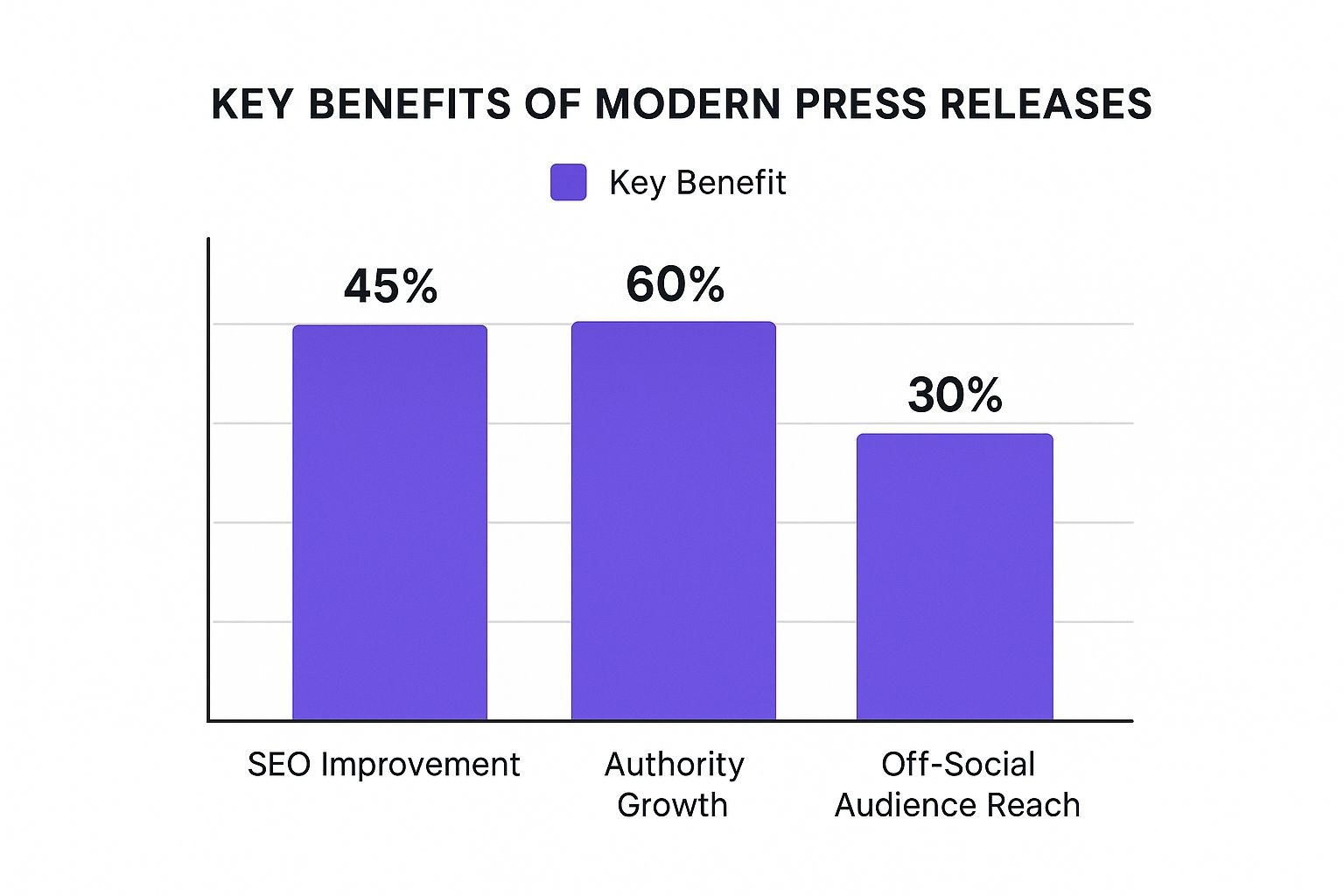
As you can see, the biggest win comes from building authority (60%!), which is a huge long-term goal for any event organizer.
It also puts your event in front of people who aren't constantly scrolling through social media. Plenty of potential attendees, sponsors, and partners still get their information from traditional news sites, industry blogs, and email newsletters. A press release is your direct line to them.
A well-distributed press release is a multi-purpose tool. It can be repurposed into blog posts, social media content, and email newsletter updates, extending its value far beyond the initial announcement. This approach maximizes your content creation efforts and ensures consistent messaging across all your promotional channels.
Building a Press Release That Journalists Will Actually Read
Let's be real: journalists are drowning in emails. Crafting a press release for an event that actually gets opened, let alone read, isn't about following a dusty old template. It's about respecting their time. Your goal is to give them a story, not just an announcement, and make their job as easy as possible.
Your headline is everything. It's the first—and often the only—thing a journalist will read. It has to be direct, punchy, and instantly signal why your event is news. Ditch the fluffy marketing speak and get straight to the point with action verbs and specific details.
Right after the headline, the opening paragraph has to do all the heavy lifting. This is where you lay out the 5 Ws: Who, What, When, Where, and Why. A busy journalist should be able to pull a complete, accurate brief about your event from this single paragraph. If they can't, they'll just move on.
Adding Depth and a Human Touch
Okay, you've covered the basics. Now it's time to build the story in the body of the release. This is your chance to go beyond the logistics and explain why this event matters. What's the bigger picture? What problem are you solving or what unique experience are you offering?
This is also the perfect spot for a killer quote. A powerful statement from a keynote speaker, an organizer, or a key partner can transform a dry announcement into something with personality. It adds a crucial human element and gives reporters a ready-made soundbite for their article.
A great quote doesn’t just rehash information already in the press release. It should inject passion, offer a unique perspective, or reveal the core mission behind the event. Think emotion and expertise, not just facts.
Getting the structure right is just as important as the words you use. A clear, scannable format makes a world of difference. If you're feeling stuck, checking out a solid press release for an event sample can give you a fantastic blueprint to follow.
The Finishing Touches That Matter
Don't stumble at the finish line. Every professional press release needs two final, non-negotiable sections.
First is the boilerplate. This is your company's official elevator pitch—a short, standardized paragraph that tells journalists who you are and what you do. It provides essential context at a glance.
Finally, and most importantly, make your media contact information impossible to miss. Include the name, title, email, and direct phone number of the person who can handle inquiries. The easier you make it for them to get more details, the more likely they are to actually follow up.
To pull it all together, think of your press release as having a distinct anatomy. Each part serves a very specific purpose.
Anatomy of an Impactful Event Press Release
Here’s a simple breakdown of the core components and how to make each one work for you.
| Component | Purpose | Pro Tip |
|---|---|---|
| Compelling Headline | Grab immediate attention and summarize the core news. | Use strong action verbs. Always include the event name and key date. |
| Intro (The 5 Ws) | Provide all essential facts in the first paragraph. | Write it so a journalist could literally copy and paste it as a short brief. |
| Body Paragraphs | Expand on the story and provide valuable context. | Focus on the "why." What makes this event different and newsworthy? |
| Quote | Add a human voice, credibility, and perspective. | Choose a quote that conveys genuine emotion or a strong, interesting opinion. |
| Boilerplate | Offer a standard, brief overview of your company. | Keep it concise and use the exact same one across all your press materials. |
| Media Contact | Provide a direct line for journalist inquiries. | List a dedicated contact who is prepped and ready to respond quickly. |
Nailing these elements doesn’t just get your press release read—it builds relationships with the media by showing them you understand what they need to tell a great story.
Finding the Newsworthy Angle for Your Event
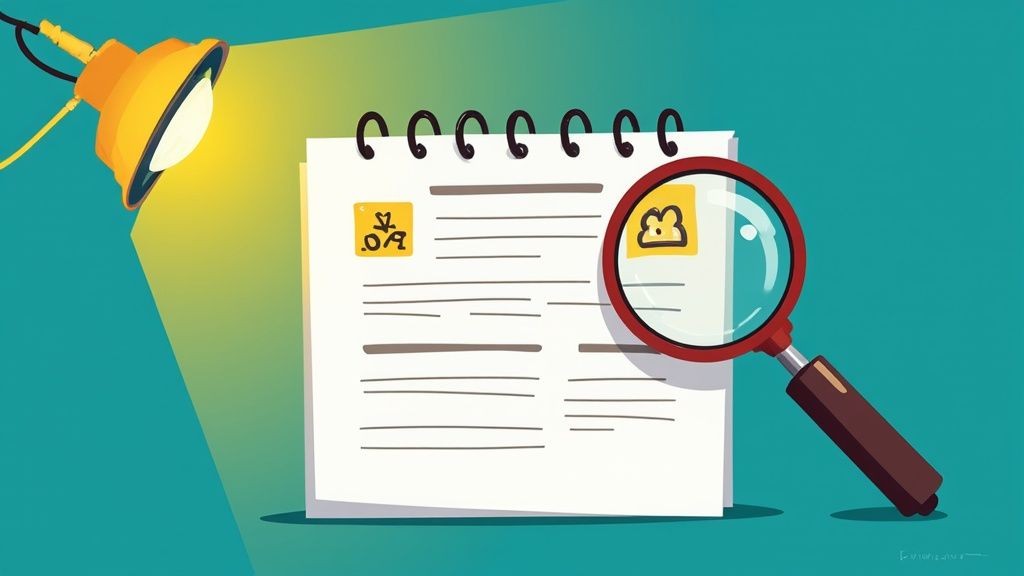
Let's be blunt: just hosting an event isn't news. To get a journalist to even open your email, your press release for an event needs a compelling "hook"—that one unique angle that elevates your announcement from a simple calendar entry to a genuine story.
So, what actually makes an event newsworthy?
Start by thinking beyond the basic "what, where, when." Is this the first event of its kind in your city? Are you finally launching that product everyone’s been buzzing about? Maybe you snagged a high-profile keynote speaker or partnered with a big-name organization. Any of these could be the hook that grabs a reporter's attention.
The real trick is to frame your event's story in a way that connects with a much broader audience. Don't just announce what's happening; explain why anyone should care. That shift in perspective is what separates a promotional flyer from a legitimate news story.
Identifying Your Unique Story
To dig up that killer hook, you need to ask some tough questions about your event. The answer is usually hiding in one of these areas:
- Timeliness: Does your event tie into a current trend, a recent news story, or an upcoming holiday? Linking your event to something people are already talking about makes it instantly relevant.
- Impact: How will your event tangibly affect the local community or your industry? Think job creation, groundbreaking research reveals, or major strategic partnerships.
- Human Interest: Is there a powerful, personal story behind your event? Maybe it's a fundraiser for a local hero or a celebration of a milestone achievement against all odds. These are the emotional connections that make for unforgettable stories.
- Uniqueness: What makes your event stand out in a sea of sameness? Is it the sheer scale, the mind-blowing technology involved, or a completely novel concept nobody has tried before?
Once you've found your angle, the next challenge is presenting it with a professional, objective tone that still feels engaging. Ditch the over-the-top marketing fluff and stick to the facts. Let the strength of your story do the heavy lifting.
The Power of Multimedia in Your Press Release
In a journalist's crowded inbox, words alone often just blend into the noise. This is where multimedia becomes your secret weapon. High-quality visuals can dramatically increase the odds of your press release getting noticed and picked up.
From our experience, a well-placed image or a short video can make an announcement absolutely pop. Including professional speaker headshots, a highlight reel from a past event, or even just your company logo adds a layer of polish and gives journalists ready-to-use assets. You're saving them time, which makes your story that much more appealing to publish.
A press release with compelling visuals is no longer just an announcement—it’s a complete story package. You're not just telling journalists about your event; you're showing them why it's worth covering.
The data absolutely backs this up. A recent look at public relations statistics shows that a whopping 63% of companies now include images, videos, or infographics with their event press releases to boost engagement. In a fast-scrolling digital world, visual content is what drives higher pickup rates and social sharing.
By providing a full suite of assets, you make your press release for an event a turnkey solution for a busy reporter, massively increasing its value and shareability.
Getting Your Press Release into the Right Hands
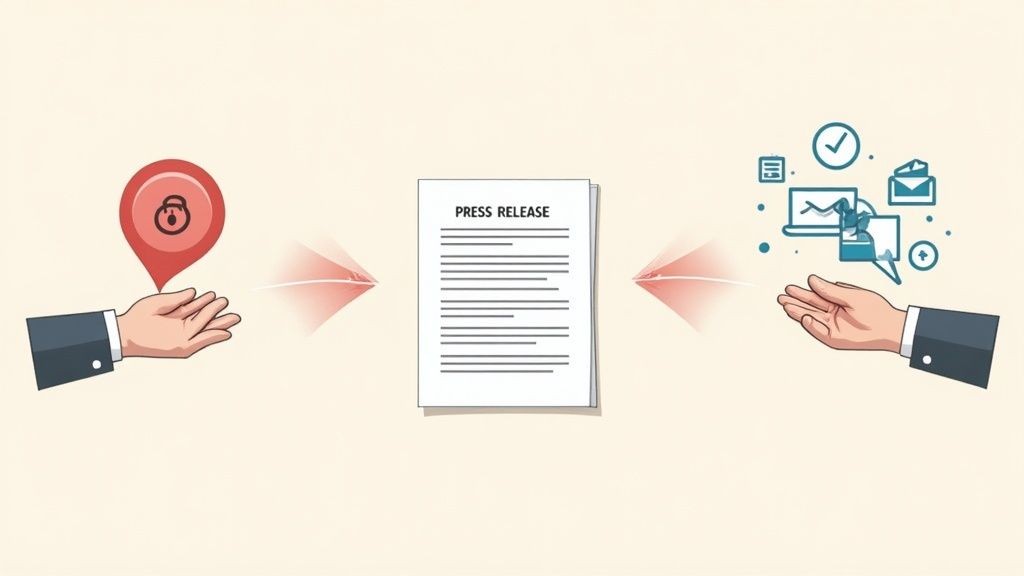
You’ve done the hard work. You’ve crafted the perfect press release, complete with a killer hook and eye-catching visuals. But even the best press release for an event is totally useless if it just sits in your drafts folder. Now comes the critical part: distribution. It's time to get your story in front of the people who can actually amplify it.
Right away, you'll face a key decision. Do you blast it out using a press release wire service, or do you build a curated media list for personalized outreach? In our experience, the most successful campaigns don't choose. They do both.
The Power of a Dual Distribution Strategy
Think of your distribution strategy as a two-pronged attack. Wire services are fantastic for casting a wide net. They syndicate your release to hundreds—sometimes thousands—of news outlets, websites, and databases. This is a huge win for SEO, building backlinks, and making sure your event announcement is officially indexed and searchable online.
But that wide net rarely catches the biggest fish. Let's be honest, top-tier journalists and influential bloggers in your niche aren't scrolling through a generic wire service feed for their next big story. That’s where a direct, personal approach becomes your secret weapon.
The most effective campaigns combine broad syndication with direct, tailored pitches to journalists and influencers. This dual strategy recognizes that while journalists receive hundreds of pitches daily, they still value official sources.
This blended approach gives you maximum visibility while also letting you build real, meaningful relationships with the media contacts who matter most to your event's success.
Building Your Targeted Media List
Creating a custom media list is definitely more work, but the payoff is enormous. This isn't just about scraping a list of email addresses; it's about building a curated directory of actual human beings who are genuinely interested in what you have to say.
Your goal is to find reporters, bloggers, and influencers whose "beat," or area of focus, aligns perfectly with your event.
- Local Media: If your event is in-person, local news stations, radio shows, and community blogs are your best friends. They are always on the hunt for stories that impact their audience directly.
- Industry Publications: Pinpoint the top trade magazines, websites, and newsletters in your niche. Getting coverage here instantly positions you as an industry leader.
- Influencers and Bloggers: Look for social media personalities and bloggers who cover topics related to your event. A single mention from the right person can drive serious ticket sales and buzz.
Crafting the Perfect Pitch
Once you have your list, whatever you do, avoid sending a generic, copy-pasted email. A personal touch makes all the difference.
Keep your pitch email incredibly brief and to the point. We always recommend starting by mentioning a recent article they wrote that you genuinely enjoyed. It immediately shows you’ve done your homework.
Then, clearly state your newsworthy angle in one or two sentences and attach the full press release. This kind of personalized outreach is a cornerstone of a wider communication strategy.
While mass distribution has its place, it's this tailored, thoughtful outreach that secures high-quality coverage. It respects the journalist's time and proves you have a story that's relevant to them. This dual approach is essential, especially when you consider that 77% of journalists prefer to get news from official press releases because they provide the accuracy and context other channels often miss, according to research from Mediaboard.com.
Making Smart Investments in Press Release Distribution
Let's talk money. Writing a great press release is one thing, but getting it in front of the right people often means opening your wallet. Understanding the costs of distribution is key to making a smart decision that actually helps you hit your goals, whether you're trying to pack a local workshop or make a splash on the global stage.
Think of it this way: you wouldn't use international air freight to send a package across town. The same logic applies here. Press release wire services offer different tiers of reach and impact, and you need to pick the one that fits your event.
Weighing the Costs of Distribution
The right service comes down to one simple question: who are you trying to reach? A local bake sale and a major international tech conference have wildly different audiences, and your distribution strategy should reflect that.
- Regional Distribution: If your event is for people in a specific country or continent, a regional service is your best bet. It focuses your budget on getting the news to local media, bloggers, and industry outlets that your target audience actually reads. No sense paying for eyeballs in Asia if your event is in Austin.
- Global Distribution: For virtual events with a worldwide audience or big industry trade shows, a global wire service gives you the broadest reach possible. This is the premium option, designed for maximum visibility across different countries and time zones.
So, what does this actually cost? A recent analysis of distribution services gives us a good ballpark. Regional services targeting markets like Europe or the Americas can run anywhere from €950 to €3,500. If you need to go global, you could be looking at costs between €1,500 and €9,500, depending on how massive their media list is.
Is It Actually Worth the Investment?
This all leads to the million-dollar question: is it worth it? The value isn't just in how many websites publish your release. It’s about the real-world results that follow.
An effective distribution plan isn't an expense; it's a strategic investment in your event's success. The media coverage you get drives brand visibility, sells tickets, and builds credibility that lasts long after the event is over.
The numbers back this up. Despite the costs, a solid 68% of businesses report a noticeable jump in visibility after sending out a press release. That’s a clear return on investment.
Every article or mention acts as a third-party endorsement, building trust with potential attendees and sponsors in a way that advertising just can't. To really get into the weeds of tracking this, check out our complete guide to calculating your event marketing ROI.
When you fund your distribution properly, you turn a simple press release from a static announcement into a machine for generating buzz and revenue.
Your Questions About Event Press Releases Answered
As an event marketer, you're always juggling a dozen different tasks. We get it. Crafting and distributing a press release can feel like one more thing on an already overflowing plate, and it often brings up a ton of questions.
Let's cut through the noise and tackle some of the most common uncertainties we hear about using a press release for an event.
When Is the Best Time to Send an Event Press Release?
Timing is everything. Send your release too early, and it gets lost in the digital shuffle. Send it too late, and you’ve completely missed the boat.
The sweet spot is generally three to five days before you want the news to break.
This gives journalists enough breathing room to review your story, ask any follow-up questions, and slot it into their editorial calendar without feeling rushed. For a really big event, you might even consider sending a "save the date" teaser a few weeks out, followed by the main announcement closer to the big day.
Should I Use a PDF or Plain Text in My Email?
This is a classic debate, but the answer is refreshingly simple: always paste the press release directly into the body of your email. Never, ever send it only as a PDF attachment.
Think about it from their perspective. Journalists are drowning in emails daily and are rightfully wary of opening attachments from strangers. More importantly, making them download and open a separate file is extra work—and that tiny bit of friction is often enough to get your pitch sent straight to the trash.
You can still attach a PDF for their convenience, but the full text absolutely must be scannable right there in the email itself.
Your number one job is to make a journalist's life easier. Remove every possible barrier, from attachments to fuzzy headlines, and you'll dramatically boost your chances of getting noticed.
How Can I Follow Up Without Being Annoying?
Following up is a delicate dance. You need to stay on a journalist's radar without becoming a pest. Our rule of thumb is to wait two to three business days after your initial email before sending a gentle nudge.
Keep your follow-up incredibly short and sweet. A simple, one-line check-in is all you need.
- "Hi Journalist's Name, just wanted to quickly follow up on my note about the Event Name. Happy to provide any more info you might need!"
If you don’t hear back after one follow-up, it’s usually best to move on. Persistence is great, but pestering is a surefire way to get your emails ignored forever.
What Metrics Should I Use to Measure Success?
Measuring the success of a press release goes way beyond just counting how many outlets ran your story. While "placements" or "pickups" are a fantastic start, you should be tracking metrics that show a real impact on your event's goals.
Here are the key indicators we always look at:
- Website Referral Traffic: Did you see a jump in visitors coming from the news sites that covered your release?
- Direct Traffic and Branded Searches: Are more people searching for your event by name now that the news is out?
- Social Media Mentions: Track how many times your event, speakers, or hashtag were mentioned on social platforms.
- Ticket Sales or Registrations: This is the ultimate metric. Can you draw a straight line from your media outreach to an increase in sign-ups?
By tracking these outcomes, you can prove the real, tangible value your press release delivered.
At Add to Calendar PRO, we believe in making every part of event promotion seamless. Once your press release drives traffic and interest, ensure attendees never miss your event with the easy-to-use "add to calendar" buttons provided by our service. Discover how our service can boost your event attendance.
